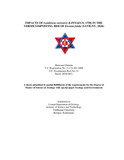Please use this identifier to cite or link to this item:
https://elibrary.tucl.edu.np/handle/123456789/1418| Title: | Impacts of Lumbricus Terrestris (Linnaeus, 1758) in the Vermicomposting Bed of Eisenia Fetida (Savigny, 1826) |
| Authors: | Ghimire, Shreeram |
| Keywords: | Lumbricus terrestris;Eisenia fetida;Impacts |
| Issue Date: | 2070 |
| Abstract: | Vermicomposting is being used by farmers to produce high quality organic manure for farm practices in Nepal. Eisenia fetida is generally used in vermicomposting process in a windrow bed just above soil. Direct contact of vermicomposting bed with soil always opens possibility of mixing of anecic worms such as Lumbricus terrestris from soil. The study was conducted with the prime objective of assessing impacts of such mixing of L. terrestris in vermicomposting bed of E. fetida comparing monoculture and polyculture beds. Two polyculture treatments were designed as one with 33.33% and another with 50% L. terrestris. It focused on comparing nutritional value of vermicompost and population growth of E. fetida with proportion of L. terrestris in each bed. Nitrogen, Potassium and Phosphorus were analyzed by using Kjeldahl method, Flame photometry method and Vanadate-molybdate method respectively while population of E. fetida was counted manually. Rates of both population growth and biomass growth were compared between monoculture and polyculture treatments. Correlation coefficient analysis showed proportion of L. terrestris had strong negative (−0.94) relation with nitrogen content, moderate negative (−0.78)relation with phosphorus content, weak positive (0.39) with potassium content and weak negative (−0.15) with population of E. fetida . p-value of correlation showed significant correlation (p<0.05) of proportion of L. terrestris with nitrogen and phosphorus content of vermicompost but not significant correlation with final population of E. fetida and potassium value of vermicompost. Average population multiplication rate of E. fetida was 39.63 times in monoculture bed followed by 38.98 times and 39.35 times in two polyculture bed respectively. Estimated nitrogen content, phosphorus content and final population of E. fetida were 186.27% (2.92% in monoculture and 1.02% in polyculture), 15.52% (0.67% in monoculture and 0.58% in polyculture) and 1.12% (813 in monoculture and 804 in polyculture) higher in monoculture bed compared to polyculture bed but potassium was 2.56% (1.17% in monoculture and 1.20% in polyculture) lower in monoculture bed. The study indicated that L. terrestris greatly affected nutritional value of vermicompost rather than population growth process based on facts that nitrogen percentage reduced when L. terrestris was introduced in vermicomposting bed of E. fetida. Monoculture bed was better than polyculture bed for vermicomposting in terms of quality of vermicompost and population growth of E. fetida. So, contamination of L. terrestris in the vermicomposting bed of E. fetida should be avoided to preserve nutrient value of vermicast produced by E. fetida and population growth of the species. Microbiological and other chemical parameters like heavy metal concentration should be studied to investigate more impacts. |
| URI: | http://elibrary.tucl.edu.np/handle/123456789/1418 |
| Appears in Collections: | Zoology |
Items in DSpace are protected by copyright, with all rights reserved, unless otherwise indicated.

